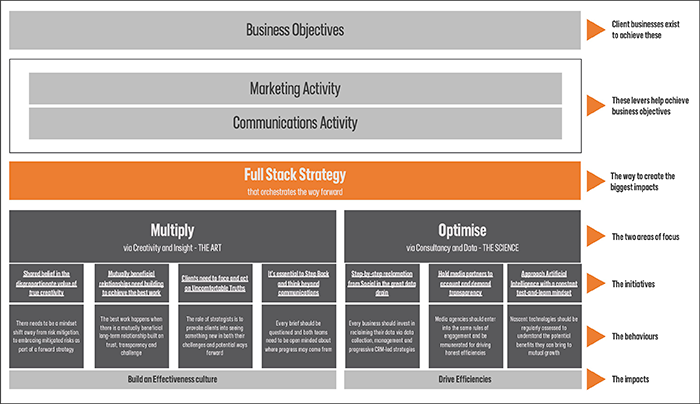Strategy teams' relationship to their clients can unlock disproportionate value, says iris' Mark Hadfield. Here are seven steps to think about.
We’ve arrived at a time when the perception of risk is hugely negative. We see businesses unwilling to take strategic leaps or embrace failure and are unable to convince their board that ‘risk’ is a positive.
Many clients are embracing category certainty and turning their back on true differentiating cultural creativity. This becomes the perfect breeding ground for consultancies and efficiency-driven thinking to enter – bringing with them certainty and incremental growth.
Yet the cost-efficiency certainty isn’t as certain as some would like you to believe, with the World Federation of Advertisers speculating that as much as 72% of a client’s working media spend being lost along the murky chain.
And what happens when optimisation drives ever-slimmer returns and doesn’t achieve growth targets? The answer, as we’ve seen countless times before in history – is creativity. Original ideas, powerful thoughts, new provocations are demonstrably effective.
As we know, creativity can deliver a multiplier effect that of 11x the value of non-creative strategies. But let’s be clear – the multiplier is only the start, because every multiplier also needs an optimiser.
If Faris Yakob is right with his proclamation that “Strategy informs the need for advertising, Planning informs the advertising” – then it makes sense that strategy teams should guide a client beyond planning and into strategy.
It is imperative that agencies embrace a ‘Full Stack Strategy’ team, with capabilities that span the internal marketing function and external customer experience – to really leverage the Multiply & Optimise model for sustainable disproportionate growth.
The 7 components of multiplying and optimising disproportionate growth
1) Shared belief in the disproportionate value of true creativity
There needs to be a shared understanding that creativity can be a disproportionate differentiator and driver of business returns. Clients need to understand and demand rigour from their agencies, but they also need to acknowledge that the agencies know more about creativity and what will achieve results.
More agencies and clients need to come to an agreement like DDB and Avis, to trust each other’s experience and expertise:
.png)
2) Build mutually beneficial relationships to achieve the best work
The first barrier to overcome is the reluctance for agencies to proudly admit to their clients that they are profit-driven companies themselves. There is no shame in charging a reasonable fee if the work is helping drive growth. Clients need to break the procurement-driven mindset that agency profitability is the enemy. It is possible for both parties to drive a fair and reasonable profit from working with each other.
3) Clients need to face and act on uncomfortable truths
A trusted agency partner who is acting in the longer-term interests of its client, and not in short-term fear, should exist to share uncomfortable truths. They may be difficult to hear but can help identify barriers and opportunities for growth. The agency should see every uncomfortable truth as valuable, and not fear sharing it. Clients, on the other hand, should appreciate every uncomfortable truth as it is intended – an opportunity for growth.
4) Step back and think beyond communications
It’s easy for a client to believe that every problem can be solved with communications and it’s easy for an agency to accept every brief without questioning it. If this happens then points 1-3 above become redundant.
Every brief should be questioned, with the stated objectives and outcomes being the main aims. Everything else should be negotiable.
This is where the ‘Full Stack Strategy’ comes into its own: If the agency believes the brand advertising brief’s objectives can be better achieved with a CRM programme or more friction-free path to purchase – it can still meet the objectives of the brief, but with different teams and strategies.
5) Reclaiming data from the great social drain
Hindsight is always a wonderful thing, with countless clients asking themselves: “Why did we ditch our owned CRM platform and invest everything in Facebook?” Of course, it made sense at the time – But now? There is no time like the present for clients to address this issue and start to reclaim their own data for their own benefit.
6) Accountable and transparent media partners
With the role of media becoming ever-more important in today’s multi-channel world, it’s easier for efficiencies to be gained – but also for waste to be covered up. The media industry has been through a rough ride the past few years, but now is the time to insist on transparent, truthful and trusted media partners. One that simplifies what their wealth of data means for advertisers.
7) A test-and-learn mindset with artificial intelligence (AI)
The machines are here and they’re here to stay. Those who embrace beneficial AI will prosper, but buyer beware – ‘beneficial’ must be to both parties. If the AI solution is asymmetrically beneficial, it’ll lead to a relationship breakdown. Both agencies and clients should have an innovation lead whose job is to constantly identify, assess and approve beneficial AI to their organisations. Crucially, they should employ a ‘should not could’ mentality to ensure robust assessment.
As your agency or business negotiates these turbulent times, only by pursuing disproportionate growth with a full stack strategy, focusing on multiplying creative impact and optimising returns, can objectives be achieved.


